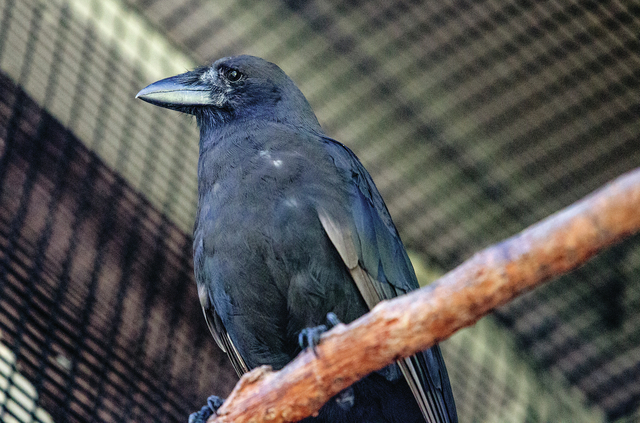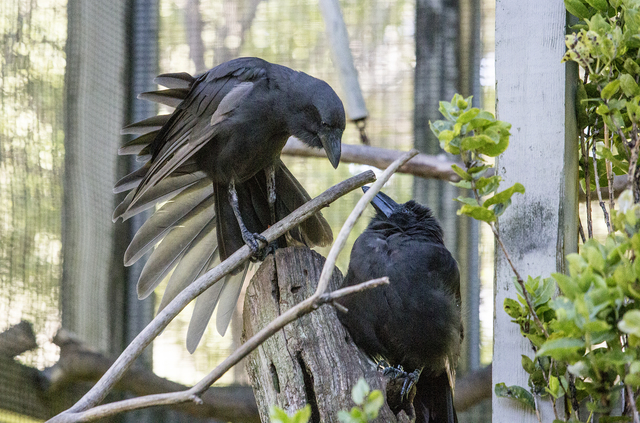Experts work to improve ‘alala’s chances
Thursday evening’s community talk at Mokupapapa Discovery Center was more difficult than usual for ‘Alala Project outreach and education specialist Lea Ka‘aha‘aina.
ADVERTISING
Last year, talks focused on plans for the long-awaited release of ‘alala (Hawaiian crow) back into the wild, where they have been extinct since 2002.
This talk had to address the reality of reintroduction efforts: Nature is an unforgiving habitat.
The first five ‘alala, all juvenile males, were released in December into Pu‘u Maka‘ala Natural Area Reserve. But within a week, three were found dead. Necropsies performed found that two birds were killed by a natural predator, the ‘io (Hawaiian hawk), and one died of starvation.
The remaining two birds were brought back to the Keauhou Bird Conservation Center, home base for several ongoing bird reintroduction and population restoration efforts, including the ‘alala project. Plans to release a second cohort of female birds were put on hold.
The community’s response in December was a largely an outpouring of support and encouragement, Ka‘aha‘aina said.
“The public really does have a good understanding and good continued support (of the releases),” she said.
That understanding is in part thanks to ongoing outreach efforts. From frequent social media updates on Facebook and Instagram to special events (a pre-release celebration last year drew more than 600 people), word of mouth has been key in keeping people aware of all that goes into ‘alala reintroduction.
More than 40 people attended Thursday’s talk to learn more about what would happen next.
“This was not the outcome that we had hoped for, but it was also not unexpected,” Ka‘aha‘aina told the group. “It was a good reminder for all of us who work on the project, as well as all of you out in the public, that the nature of reintroductions is that they’re inherently challenging.
“It is not an easy thing that we are trying to do here.”
The ‘alala release has already been years in the making, as partner agencies try to successfully introduce the birds back into their native habitat on the slopes of Mauna Loa and Hualalai. Similar reintroduction efforts in South Kona in the 1990s also struggled with the ‘io problem, as well as avian disease.
There are currently 130 ‘alala in the world, all of which were born in captivity.
“Reintroduction efforts around the world take multiple releases over many years before showing any signs of success,” Ka‘aha‘aina said, using another Hawaii example to illustrate the point. The nene was brought back from the brink of extinction, from 30 birds to 3,000, but it took more than five decades to reach that point.
“We can expect a long and challenging road ahead, but the nene also gives us hope, right?” Ka‘aha‘aina said. “We know that it is possible.”
The next ‘alala release is planned for late summer or early fall. Three key changes will be made to the program in the meantime.
There will be a new release location at a higher elevation within Pu‘u Maka‘ala, in an effort to keep the ‘alala out of ‘io range. The hawks typically have territories no higher than 5,200 feet above sea level. They will venture higher than that range, Ka‘aha‘aina said, but the chances of an ‘alala running into a predator should still be reduced by the change of location.
The release site will have more supplemental food available, to help birds as they learn to apply their foraging skills in the wild.
More birds will be released at once: a total of twelve, including the two males who survived the first attempt. Seven females and three more males comprise the rest of the group. Two of the birds will also be parent-reared (as opposed to hand-rasied by humans).
And all of the birds will receive more predator aversion training. That component was included in the first group’s training, but was not enough to keep the birds safe.
The Keauhou Bird Conservation Center consulted with biologist Tom White, who is working on a reintroduction effort for Puerto Rican parrots. The parrots also have a native raptor predator and require aversion training.
Training consists of a three-day program where an ‘alala and an ‘io are placed at opposite ends of an enclosure, separated by a barrier but able to see one another.
“Fear stimuli” will then be introduced, so the ‘alala associate the ‘io with a threat. The stimuli itself is still being determined, Ka‘aha‘aina said, but could include playing ‘alala distress calls or flying an ‘io silhouette over the enclosure.
The ‘alala will then be tested to see how they respond to the ‘io the next time they see it. The reaction “could be a factor in deciding if it’s a release candidate,” Ka‘aha‘aina said.
‘Alala, like other members of the crow family, are considered to be among the most intelligent types of bird species. They have been documented using tools to access food.
The predator aversion training is still being developed, so the two birds that were brought back to the center have not had a chance to see an ‘io. It’s not yet know how they would react upon seeing the predator.
Ka‘aha‘aina took a host of questions from attendees, who were eager for details about how predator aversion training worked, and what the chances were for the next cohort of birds.
Pat Richardson of Hilo said she first became interested in the ‘alala when it was still in the wild and groups were trying to figure out the best way to save the shrinking population. Since then, she’s attended just about every ‘alala-related presentation given on the Big Island.
Artist Rosy Bartsch was at her first ‘alala meeting. A sculptor, she used to make works featuring the ‘alala, and came to the talk to see if it might spark some inspiration for new art.
“I think it did,” Bartsch said afterward. “This was very good.”
Kaulana Hokoana took detailed notes on his laptop during the Thursday talk. He found out just two days before that he would be teaching a Halau Kupukupu Innovations Academy summer program at Kamehameha Schools focused on ‘alala, and promptly started following the ‘Alala Project on its social media accounts.
“Perfect timing,” he said about the program. “It’s kind of like it was meant to be, in a way.”
“My biggest takeaway is that everyone has an influence on the restoration,” he said. “In my case, it’s spreading it to my students. It’s just getting people informed.
“And,” Hokoana added, “that not all hope is lost.”
Email Ivy Ashe at iashe@hawaiitribune.com.




